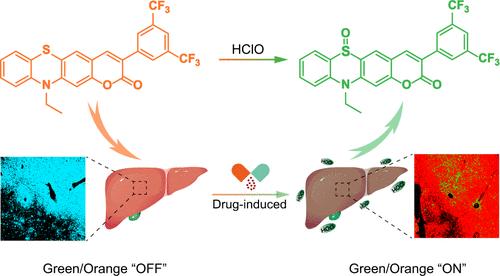通过诱导分子聚集抑制TICT形成的工程HClO比率荧光探针监测药物性肝损伤
IF 6.7
1区 化学
Q1 CHEMISTRY, ANALYTICAL
引用次数: 0
摘要
开发高特异性次氯酸盐(HClO)比例荧光探针对阐明药物性肝损伤(DILI)及其相关生物学问题具有重要意义。吩噻嗪衍生香豆素(PTZC)荧光团已被证明对HClO具有高特异性;然而,由于固有的扭曲分子内电荷转移(TICT)效应,这种荧光团在水介质中发出微弱的荧光,导致对HClO只有开启模式响应。在这项工作中,我们提出了一种分子设计策略,通过诱导PTZC荧光团在水介质中形成纳米聚集体来抑制TICT的形成,用于HClO比率荧光探针的设计。基于该策略开发的探针PBFF可以在水介质中形成相当大的纳米聚集体来抑制TICT的形成,而不会受到聚集引起的猝灭效应的影响,从而使其在水介质中发出强烈的荧光(Φf = 0.20)。重要的是,PBFF对HClO具有特异性和敏感性(LOD = 15.7 nM),表现出明显的比例荧光变化。进一步的实验结果表明,PBFF可以通过hcl诱导的荧光比值变化灵敏地监测原位DILI的进展。这种通过在水介质中诱导分子聚集来抑制TICT形成的策略将推动比率荧光探针在未来的发展。本文章由计算机程序翻译,如有差异,请以英文原文为准。

Engineering HClO Ratiometric Fluorescent Probe by Inducing Molecular Aggregation to Suppress TICT Formation for Monitoring Drug-Induced Liver Injury
Developing highly specific hypochlorite (HClO) ratiometric fluorescent probes for elucidating drug-induced liver injury (DILI) and related biological issues is of great significance. Phenothiazine-derived coumarin (PTZC) fluorophores have been shown to exhibit high specificity in response to HClO; however, such fluorophores emit dim fluorescence in aqueous media due to the intrinsic twisted intramolecular charge transfer (TICT) effect, resulting in only a turn-on mode response to HClO. In this work, we present a molecular design strategy of suppressing the TICT formation by inducing PTZC fluorophores to form nanoaggregates in aqueous media for the HClO ratiometric fluorescent probe design. The probe PBFF developed based on this strategy can form considerable nanoaggregates in aqueous media to inhibit the TICT formation without suffering from the aggregation-caused quenching effect, thus allowing it to emit intense fluorescence in aqueous media (Φf = 0.20). Importantly, PBFF can specifically and sensitively (LOD = 15.7 nM) respond to HClO, showing distinct ratiometric fluorescence changes. Further experimental results show that PBFF can sensitively monitor in situ DILI progression through HClO-induced fluorescence ratio changes. This strategy of suppressing TICT formation by inducing molecule aggregation in aqueous media will advance the development of ratiometric fluorescent probes in the future.
求助全文
通过发布文献求助,成功后即可免费获取论文全文。
去求助
来源期刊

Analytical Chemistry
化学-分析化学
CiteScore
12.10
自引率
12.20%
发文量
1949
审稿时长
1.4 months
期刊介绍:
Analytical Chemistry, a peer-reviewed research journal, focuses on disseminating new and original knowledge across all branches of analytical chemistry. Fundamental articles may explore general principles of chemical measurement science and need not directly address existing or potential analytical methodology. They can be entirely theoretical or report experimental results. Contributions may cover various phases of analytical operations, including sampling, bioanalysis, electrochemistry, mass spectrometry, microscale and nanoscale systems, environmental analysis, separations, spectroscopy, chemical reactions and selectivity, instrumentation, imaging, surface analysis, and data processing. Papers discussing known analytical methods should present a significant, original application of the method, a notable improvement, or results on an important analyte.
 求助内容:
求助内容: 应助结果提醒方式:
应助结果提醒方式:


